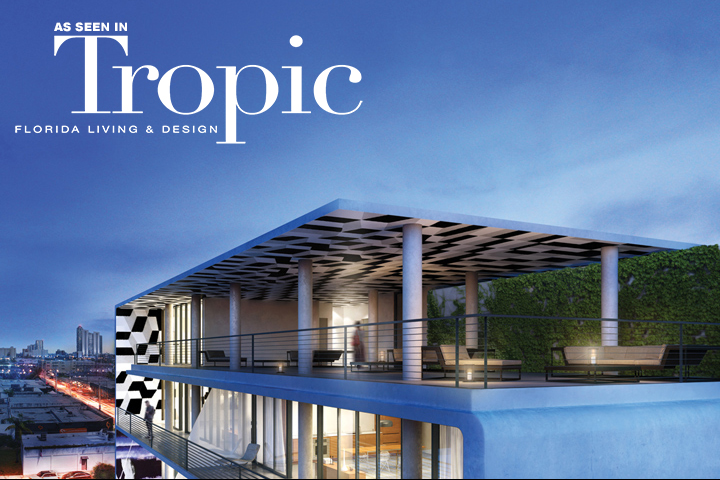
Living With Art: 250 Wynwood
By John T. O’Connor
Just west of the exploding Edgewater neighborhood and south of the ever-changing Design District, Wynwood is a constantly morphing arts district currently hosting about 70 galleries, museums and collections. It’s home to the infamous Wynwood walls, it buzzes during Art Wynwood and its former warehouses and factories are all but out of control when Art Basel makes greater Miami its home-base each December. All these things make Wynwood edgy, vibrant and a place creatives like to call home. But for all this burgeoning neighborhood does offer, one thing it lacks is housing that pays close attention to what this district is and what it wants to be. The thought of paint-splashed Wynwood doesn’t conjure images of luxury high-rises with Big Box anchor tenants, but rather feels like small, mixed-use, live-work style developments that reflect the aspirations of the creative class, remaining more accessible than nearby alternatives.
Recently breaking ground is one of those developments exactly, with a design and style that feels as if it developed right from the energy that surrounds it. And in a way, it did. 250 Wynwood is the brainchild of Bradley Carlson and David Polinsky, founding partners of Fortis Developments. When looking for the perfect spot for a mixed-use development, Carlson and Polinsky were drawn to Wynwood by its urban edginess. “It was pretty evident that Wynwood was the place to be. It was already a thing,” Carlson told us recently, “And clearly on the way to becoming something big. You could feel it in the air.” The team saw not only the potential here, but clearly identified a hole in the market. “Wynwood felt like the Meatpacking District did in 1999 – gritty and full of potential,” says Carlson. “It had galleries, clubs and plenty of places to eat, drink and shop. But after the fun, everyone vacated to other parts of the City. There was nowhere to live.”
To design a building that would speak to those wanting to call Wynwood home, Polinsky and Carlson, after a long search, selected Laith Sayigh and his New York-based firm, D-form-A. Sayigh is principal of the New York City-based firm, and comes with an amazing background, having worked at Foster + Partners in London, Diller Scofidio and Renfro in New York, and SOM in San Francisco. For 250 Wynwood, D-form-A has designed a building that combines businesses on the ground level with 11 live-work style residences above. While true to the tenets of New Urbanism, the design somehow manages to avoid the trap of portraying itself as polished or uber-chic. Its five residential levels have long, deep terraces formed by two interlocking ‘E’ formations pushing in from left and right. The result is dynamic enough right there, but because of this project’s unique location, the group decided to really bring art into the mix. To that end, Polinsky and Carlson brought in Wynwood gallerist, Anthony Spinello, a trailblazing young curator who got his start in Wynwood, to choose the artists whose work will be represented in the project, from art that hangs in the public spaces to art painted on the exterior walls and ceilings of the upper terraces. In this way, the building reminds us of Warhol’s last factory in New York, where canvases painted by Basquiat or Clemente leaned up against walls while Kieth Haring’s painted, taxidermied elephant faced the front window for years. Make no mistake, 250 Wynwood is a brilliant idea, one that promises to capture the energy of the district and reflect it back, 24 hours a day.
The Fortis team did well in selecting D-form-A to bring their dream to life. Sayigh was able to figure out what the neighborhood wanted at this particular moment, while managing to make 10-foot ceilings, room-deep terraces and floor-to-ceiling glass all standard. This is akin to walking a sort of ‘design tightrope’ that, when done properly, gives the building an air of cool. Where other architects in Miami might have opted for opulence, D-form-A has kept their finger on the pulse of Wynwood. 250 Wynwood, through its thoughtful program and design does not just play the part of urban infill, it becomes a generous contribution to the fabric of the city.

